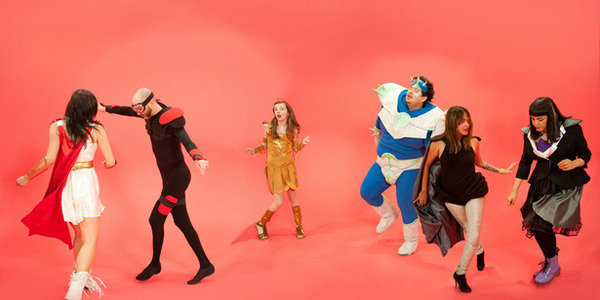Desiree Holman
dal 25/6/2011 al 17/9/2011
Segnalato da
25/6/2011
Desiree Holman
Berkeley Art Museum and Pacific Film Archive BAM/PFA, Berkeley
The video combines live action with digital animation, the space of reality and virtual reality collapsed and complicated along its progression. Each individual in "Heterotopias" imagines a character for himself or herself, realized in the flesh through Holman's 3-d models.

Curated by Phyllis Wattis, Elizabeth Thomas
Heterotopias begins with a screen, frames within a frame so to speak, as the video projection frames an image of several individuals typing away on their laptops. Their specific activities are left unseen, the screens serving as frames for everyday realities, empty ciphers for the ubiquity of our experience with them—the mundanity of work, communication, news, and information. Holman is interested in how this constant technological presence forms and mediates our sense of self and our social relations, but also how it serves as a portal to other more fantastical forms of attachment and desire in virtual space. There is total fluidity in the construction of fantasy-based cultures in virtual reality, gaming, and popular media, and Holman’s interest in fantasy and play is as complex and fluid, moving among physical, mental, and virtual realms of make-believe.
The video combines live action with digital animation, the space of reality and virtual reality collapsed and complicated along its progression. Each individual in Heterotopias imagines a character for himself or herself, realized in the flesh through Holman’s handmade props and costumes and digitally through the creation of fully rendered 3-D models. The role-playing transcends the real and the virtual, as we slip between the characters’ physical embodiments of their avatars through live action (along the range of aggressive to ecstatic) and the digital models of those same characters, inhabiting environments that refer to the origins of their characters. At times the 3-D digital models appear a bit like the virtual puppets they actually are, the visible wireframe revealing the sculptural underpinning of their making along with the apparatus of their possible movement.
The physical surrogacy explored in Heterotopias connects it to two of Holman’s other projects, which together form a trilogy that uses the tropes of media—from television and music videos to online gaming—to imagine and interrogate the human tendency to engage in fictional narratives. The Magic Window (2007) is an ecstatic mashup of quintessential TV sitcoms (The Cosby Show and Roseanne), wherein Holman’s cast dons obviously handmade masks and costumes to inhabit the iconic families and reanimate these prime-time characters with their own fictional narratives. This kind of media self-projection is contrasted with a more intimate kind of self-projection in Reborn (2009), which takes inspiration from “reborner” culture, in which women adopt hyperreal baby dolls as true children, enacting maternal role play in their daily lives. Holman meticulously crafted her own reborn dolls, and her cast of mothers imagines this role playing both realistically and absurdly, complicating the implied narcissism in this act of animism and surrogacy with more tender notions of reciprocal altruism. Whether through crude masks, hyperreal proxies, or 3-D avatars, together these works speak to the human performance of self in everyday life, and how, in an anthropological sense, that is foregrounded through performative objects.
In Heterotopias, Holman constructs a Möbius-like relation between real and virtual, self and avatar, action and play, fantasy and fiction. Rather than casting for roles, Holman’s cast invented their own characters, whose costuming conflates archetypes popular in media and role-playing games (the games themselves conflations of myth, history, and fantasy), as an expression of each individual’s desire. They may reveal internal truths rarely projected in everyday reality, as character traits are enacted to realize one’s unfulfilled desires for power or control or freedom or chaos, but these fantastical self-constructions betray in some way the real selves that they supplant. While technology generates possibility, our desires and attachments don’t transcend our own bodies and minds.
The MATRIX Program at the UC Berkeley Art Museum and Pacific Film Archive is made possible by a generous endowment gift from Phyllis C. Wattis, The Andy Warhol Foundation for the Visual Arts, and the continued support of the BAM/PFA Trustees.
For additional information, please contact Ariane Bicho, Communications
Director, at (510) 643-6494 or abicho@berkeley.edu.
Image: Desiree Holman: video still from Heterotopias, 2011; three-channel HD video, 13 min., courtesy of the artist and Silverman Gallery, San Francisco.
Opening: 26 june
Berkeley Art Museum
2626 Bancroft Way, Berkeley
Gallery and Museum Store Hours: Wednesday through Sunday, 11 a.m.–5 p.m.
Open Late Fridays until 9 p.m. Closed Monday and Tuesday.
Admission: Beginning September 1, 2010, general admission is $10;
admission for seniors, disabled persons, non–UC Berkeley students, and
young adults (13–17) is $7; admission for BAM/PFA members, UC Berkeley
students, staff, and faculty, and children under 12 is free.



